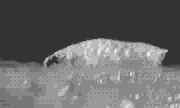

Wild-type larva
This is a Drosophila melanogaster third instar larva crawling along normally on the surface of an agar plate. Anterior is to the left where the dark mouth parts are distinguishable in the head. Notice the complex waves of contraction, flowing from posterior to anterior, that propel the larva forward. This locomotion is accomplished by the controlled contraction of layers of muscles attached to the cuticle within each body segment. Controlling this complex pattern of muscle contractions are motor neurons. The cell bodies of larval motor neurons are located in a ventral ganglion which is in the anterior-most third of the animal. The motor axons extend from the ventral ganglion in segmental nerves to innervate all the body wall musculature.

Khc mutant larva
This Drosophila melanogaster third instar larva has mutations in both copies of its kinesin heavy chain gene (Khc). (The genotype is Khc6/Df(2R)Jp6). Notice the posterior end of the animal is curved and flips upward. Mutations in Khc cause organelle jams that disrupt fast axonal transport in larval segmental nerves (Hurd and Saxton 1996 Genetics 144:1075-85). An ensuing differential loss of neuron function causes asymmetric muscle contractions in posterior segments that produce these rhythmic upward flips of the tail during crawling.
Contributed by MaryAnn Martin, Daryl Hurd & Bill Saxton
If you use material from the movie page at the Kinesin site, we ask that you cite either the home page and authors, or the appropriate source publication in your work.
Copyright 1996-2003. All rights reserved.
Created 23 February 1997 21:21 GMT
Modified 21 February 2000 20:55 GMT